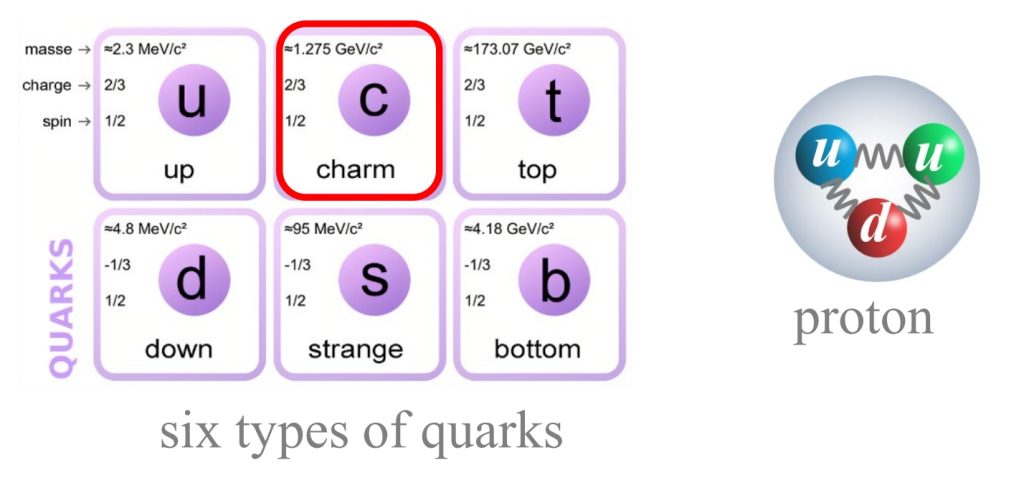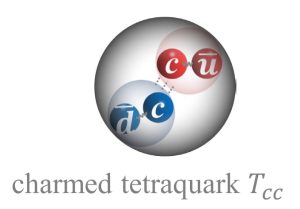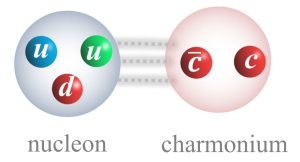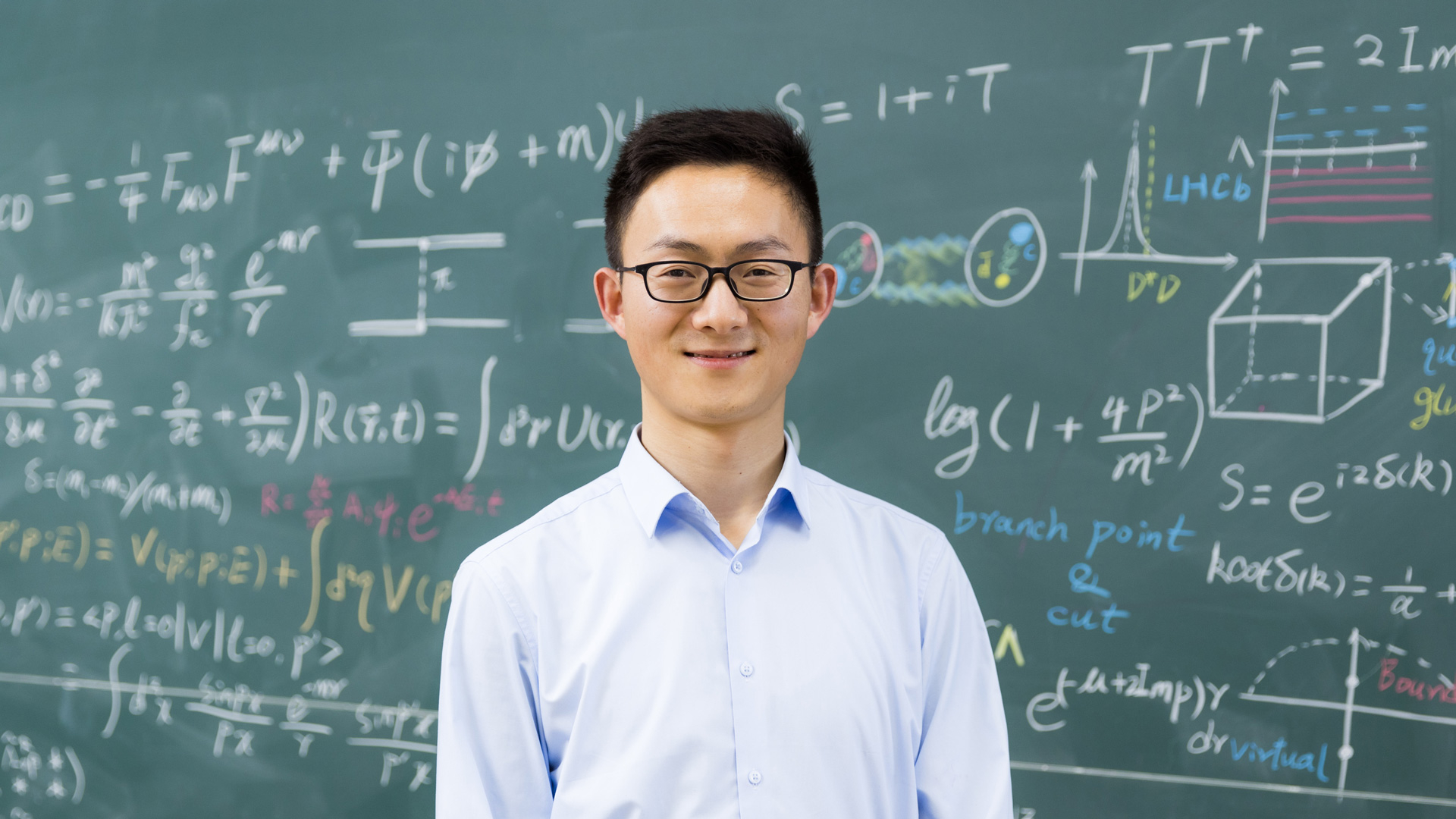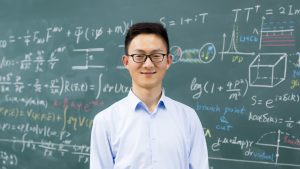 Chinese post-doctoral researcher Yan Lyu, working at iTHEMS, has made significant theoretical advances in particle and nuclear physics using lattice QCD and the supercomputer Fugaku
Chinese post-doctoral researcher Yan Lyu, working at iTHEMS, has made significant theoretical advances in particle and nuclear physics using lattice QCD and the supercomputer Fugaku
Though growing up near Xi’an, one of China’s oldest capital cities, Yan Lyu was more interested in science than ancient history. From a young age, he was fascinated with rockets and how they worked. This interest continued into high school and eventually led him to enroll at Nanjing University of Aeronautics and Astronautics.
A year into his studies, however, he developed an even deeper passion for understanding the fundamental laws underpinning particle and nuclear physics.
“I realized that the principles of rocketry and aeronautics were well understood,” says Lyu. “So I looked for a new challenge and found it in physics—in exploring the fundamental constituents and forces that make up matter.”
Consequently, he changed both his focus and institute and went on to obtain a PhD in particle and nuclear physics from Peking University in 2023.
While conducting research for his doctorate, he had collaborated with various scientists in China and abroad, including scientists who worked at the RIKEN Center for Interdisciplinary Theoretical and Mathematical Sciences (iTHEMS) in Japan. The Center aims to bring together international researchers in a variety of disciplines, including theoretical physics, mathematics and computational science, to collaborate on solving the mysteries of the Universe, matter and life.
By coincidence, iTHEMS had an opening for a researcher in nuclear physics just as Lyu was seeking an institute to start his post-doc research. He applied for the position, was accepted, and began working at iTHEMS in March, 2024.
“I’ve found that scientist with different backgrounds at iTHEMS have created a free and diverse atmosphere, and I’ve benefitted from this,” says Lyu.
Which brings us to the present and the research Lyu is currently undertaking at the Center.
Theoretical Confirmation
Lyu’s research at iTHEMS focuses on hadronic physics, a branch of physics that studies particles composed of quarks and gluons. Before exploring the details of his investigations, however, it will be helpful to familiarize ourselves with the Standard Model of particle physics: the established theory that describes the fundamental particles and their interactions. It explains 17 types of elementary particles: six quarks (Fig. 1), six leptons, four gauge bosons, and a scaler boson, along with their corresponding antiparticles. These elementary particles can combine in various ways to form subatomic particles. For example, a proton consists of three quarks bound together by gluons—gauge bosons that mediate the strong force. A neutron is also made up of three quarks. A pion, by contrast, is composed of one quark and one antiquark. Particles made of two or more quarks held together by gluons are collectively known as hadrons.
Lyu is especially interested in researching the interactions between hadrons composed of charm quarks. To do this, he uses a mathematical framework called quantum chromodynamics or QCD. In particular, he employs a form called lattice QCD, which is a kind of simulation of QCD placed on a 4D Euclidian spacetime grid or lattice—and where every point on the grid represents a position in space and a moment in Euclidean time. This complex procedure, and the calculations to extract the interactions between hadrons require the help of a supercomputer.
In October 2023, Lyu, together with researchers from several Japanese institutes and Peking University, published a paper in Physical Review Letters providing theoretical proof and explanation of the doubly charmed tetraquark discovered in 2021 by the Large Hadron Collider beauty (LHCb) Collaboration.
Usually, quarks come in combinations of two or three to form mesons and baryons. But the doubly charmed tetraquark is made of four quarks consisting of two charm quarks (a heavy type of quark) and two lighter antiquarks (Fig. 2).
While several other tetraquarks had already been discovered, this was the first to contain two heavy quarks and two light antiquarks.
To investigate further, Lyu and colleagues simulated the forces between the particles comprising the doubly charmed tetraquark using lattice QCD on the supercomputer Fugaku. The result showed that these particles attracted each other with a force nearly strong enough to bind them. And with a slight increase in the strength of this attraction, it would form a loosely bound state—something physicists call a virtual state (Fig. 3 below, left).This matched the experimental findings of LHCb, thus theoretically proving the new particle’s existence (Fig. 3 right). And it has helped physicists to better understand how hadrons interact, as well as opening the possibility of finding even more exotic particles, perhaps composed of five or six quarks.
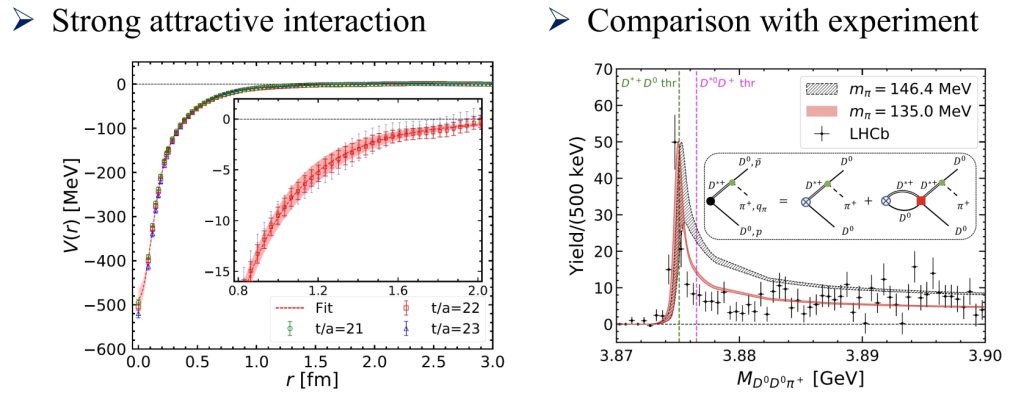
Fig. 3: Results of Lyu’s calculations. The left graph shows there are strong attractive interactions between two hadrons. In the graph on the right, the crosses represent the experimental results, while the red shaded areas indicate the results of lattice QCD calculations conducted under specific conditions. (Reproduced from Yan Lyu et. al., Doubly Charmed Tetraquark from Lattice QCD near Physical Point, Physical Review Letters 131, 161901. https://doi.org/10.1103/PhysRevLett.131.161901. Under the terms of the Creative Commons Attribution 4.0 International License.
In March this year, Lyu received the RIKEN Excellent Achievement Award in recognition of his outstanding work on elucidating the genuineness of the doubly charmed tetraquark.
Making all this possible is the power of Fugaku and the sophistication of lattice QCD, a combination Lyu has been making use of since conducting research for his PhD at Peking University when he collaborated with iTHEM scientists. “Fugaku’s computational power is remarkable,” he says. “But you can’t work on it alone. You need the help of others. And the Fugaku support teams are outstanding in every way and always eager to assist users.”
Other Achievements
Since his breakthrough in understanding the doubly charmed tetraquark, Lyu has been researching into other areas of hadron interaction in collaboration with colleagues at iTHEMS. One such effort has advanced the understanding of nucleon-charmonium interactions (Fig. 4). The results of this work were published in Physics Letters B in January.
Nucleon-charmonium interactions are the low-energy interactions between nucleons (protons or neutrons) and a charmonium, the bound state of a charm quark and its antiquark.“There has been a long-standing debate between researchers on the nature of low-energy nucleon-charmonium interactions,” says Lyu. “Different experiments have produced different results. Using lattice QCD and Fugaku, we have shown these interactions are indeed attractive—probably more attractive than many scientists expected. Knowing this helps us understand how a hadron, for instance, acquires mass.”
Earlier, he carried out research on dibaryon composite particles during his PhD candidacy. A dibaryon is a system containing two baryons, composite particles made of three quarks. Working with colleagues in Peking University and iTHEMS, Lyu investigated a dibaryon system composed of two triple charm baryons to see if these baryons interacted strongly enough to form a loosely bound state.
“We found that two charmed Omega baryons (each of which consists of three charm quarks) can form a bound state, like a deuteron—the latter being the only stable dibaryon found in almost 100 years,” says Lyu (Fig. 5). “If our findings are confirmed by experimentation, this would represent a second stable dibaryon alongside the deuteron.” The results of this research were published in Physical Review Letters in August 2021.
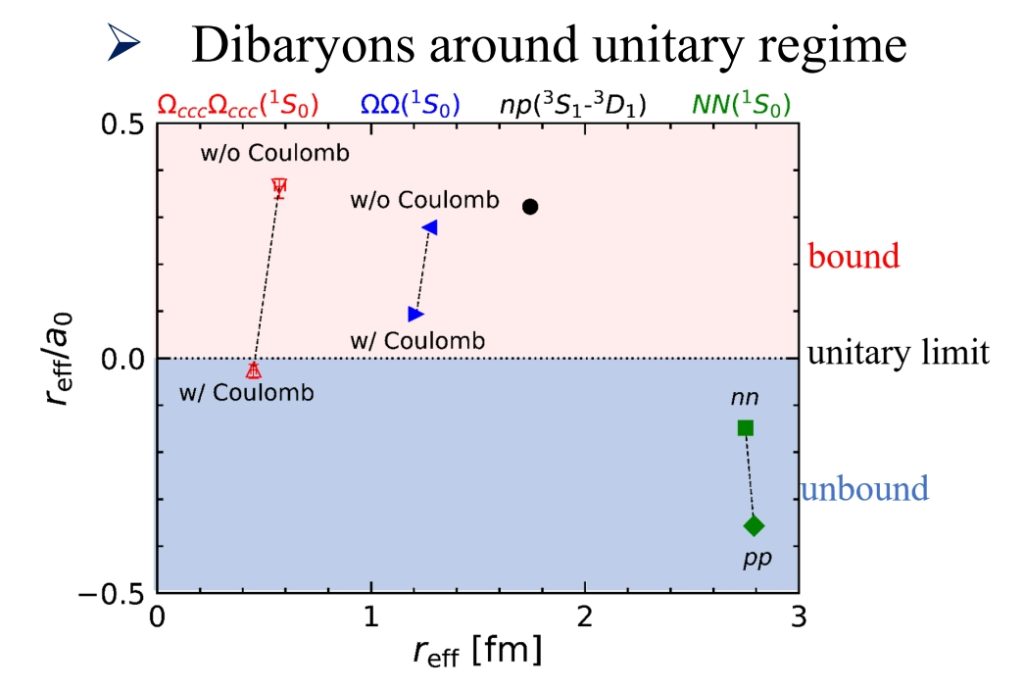
Fig. 5 Lyu’s calculations show that a pair of triply charmed baryons, Ω𝑐𝑐𝑐Ω𝑐𝑐𝑐, can form a bound state. Stable dibaryons are located in the upper half with the deuteron and Ω𝑐𝑐𝑐Ω𝑐𝑐𝑐 shown by a black dot and a red reversed triangle, respectively. (Reproduced from Yan Lyu et. al., Dibaryon with Highest Charm Number near Unitarity from Lattice QCD, Physical Review Letters 127, 072003. https://doi.org/10.1103/PhysRevLett.127.072003. Under the terms of the Creative Commons Attribution 4.0 International license.
Now and the Future
Could all these discoveries and confirmations have practical applications?
“In general,” says Lyu, “particle and nuclear physics have elucidated the mechanism of nuclear behavior, such as nuclear fission and nuclear decay, and have already contributed a lot to society. In areas like nuclear energy, for instance, and in the field of medicine with computer tomography, and also radiation therapy in the treatment of cancer.”
Concerning his own research, Lyu believes it will interest fellow researchers in his field as well as scientists in related areas such as cold atom physics. “As for any practical benefits from my findings, I do not see any direct applications,” says Lyu. “However, I have no doubt they will contribute to the benefit of society in the long run.”
Lyu will continue to work in iTHEMS for another two years. At present, he is using lattice QCD to study the nuclear force, which binds together all nuclei.
Reference
RIKEN press release (in Japanese)
スパコンで予言する魅惑の新粒子「チャームダイオメガ」
https://www.riken.jp/press/2021/20210830_1/index.html
























